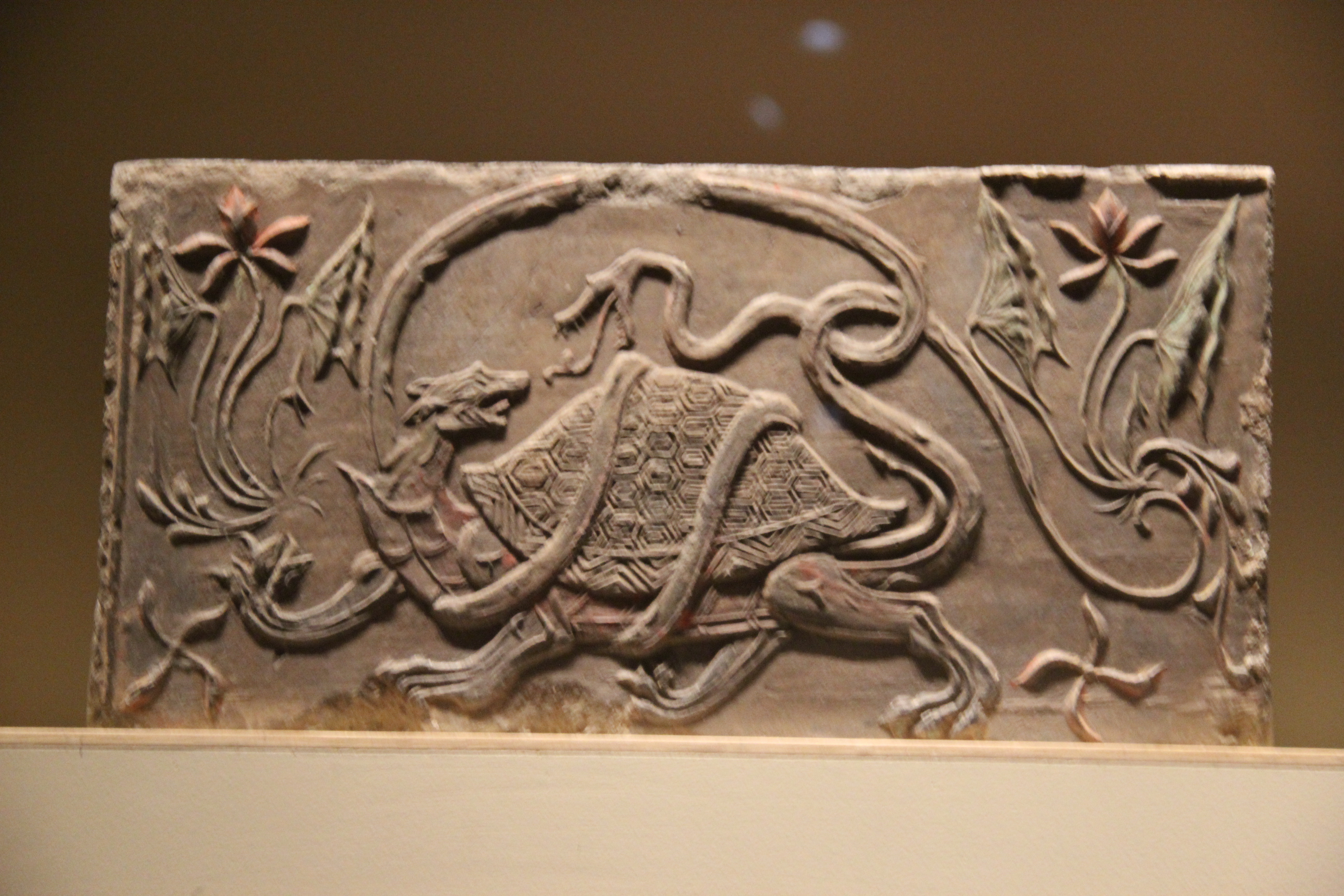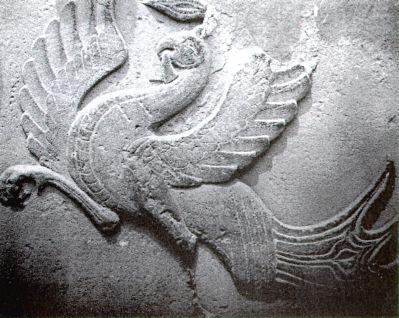|
Xuanyuan Temple
The Mausoleum of the Yellow Emperor () is the alleged burial site of the legendary Yellow Emperor (Huangdi) of China. It is located in Huangling County, Yan'an City, Shaanxi Province, China. According to legend, the Yellow Emperor attained immortality and rose to Heaven, leaving behind only his clothing and cap to be entombed. The mausoleum is located on Qiao Mountain, north of Yan'an proper. In 1961, the Chinese State Council proclaimed it as the first National State-Protected Great Cultural Site, with the identifier "Ancient Tomb #1" and the moniker "The First Tomb Under Heaven". The mausoleum was anciently called "Qiao Tomb", and was an important location where generations of emperors and famous people made offerings to the Yellow Emperor. According to historical records, the earliest offerings to the Yellow Emperor at the mausoleum's location began in 442 BCE. From the establishment of a shrine proper in the year 770 CE during the Tang dynasty, it was the scene of regular n ... [...More Info...] [...Related Items...] OR: [Wikipedia] [Google] [Baidu] |
Stele
A stele ( ) or stela ( )The plural in English is sometimes stelai ( ) based on direct transliteration of the Greek, sometimes stelae or stelæ ( ) based on the inflection of Greek nouns in Latin, and sometimes anglicized to steles ( ) or stelas ( ). is a stone or wooden slab, generally taller than it is wide, erected in the ancient world as a monument. The surface of the stele often has text, ornamentation, or both. These may be inscribed, carved in relief, or painted. Stelae were created for many reasons. Grave stelae were used for funerary or commemorative purposes. Stelae as slabs of stone would also be used as ancient Greek and Roman government notices or as boundary markers to mark borders or property lines. Stelae were occasionally erected as memorials to battles. For example, along with other memorials, there are more than half-a-dozen steles erected on the battlefield of Waterloo at the locations of notable actions by participants in battle. A traditional Wester ... [...More Info...] [...Related Items...] OR: [Wikipedia] [Google] [Baidu] |
Guo Moruo
Guo Moruo (November 16, 1892 – June 12, 1978), courtesy name Dingtang, was a Chinese author, poet, historian, archaeologist, and government official. Biography Family history Guo Moruo, originally named Guo Kaizhen, was born on November 10 or 16, in the small town of Shawan District, Shawan, located on the Dadu River some southwest from what was then called the city of Jiading (Lu) (Chia-ting (Lu), ), and now is the central urban area of the prefecture level city of Leshan in Sichuan Province. At the time of Guo's birth, Shawan was a town of some 180 families.David Tod Roy, "Kuo Mo-jo: The Early Years". Harvard University Press, Cambridge, Massachusetts. 1971. No ISBN. Guo's father's ancestors were Hakka people, Hakkas from Ninghua County in Tingzhou Prefecture, near the western border of Fujian. They moved to Sichuan in the second half of the 17th century, after Sichuan had lost much of its population to the rebels/bandits of Zhang Xianzhong ( 1605–1647). According to fami ... [...More Info...] [...Related Items...] OR: [Wikipedia] [Google] [Baidu] |
Second Sino-Japanese War
The Second Sino-Japanese War was fought between the Republic of China (1912–1949), Republic of China and the Empire of Japan between 1937 and 1945, following a period of war localized to Manchuria that started in 1931. It is considered part of World War II, and often regarded as the beginning of World WarII in Asia. It was the largest Asian war in the 20th century and has been described as The Asian Holocaust, in reference to the scale of Japanese war crimes against Chinese civilians. It is known in China as the War of Resistance against Japanese Aggression. On 18 September 1931, the Japanese staged the Mukden incident, a false flag event fabricated to justify their Japanese invasion of Manchuria, invasion of Manchuria and establishment of the puppet state of Manchukuo. This is sometimes marked as the beginning of the war. From 1931 to 1937, China and Japan engaged in skirmishes, including January 28 incident, in Shanghai and in Northern China. Chinese Nationalist and C ... [...More Info...] [...Related Items...] OR: [Wikipedia] [Google] [Baidu] |
Deng Xiaoping
Deng Xiaoping also Romanization of Chinese, romanised as Teng Hsiao-p'ing; born Xiansheng (). (22 August 190419 February 1997) was a Chinese statesman, revolutionary, and political theorist who served as the paramount leader of the People's Republic of China from 1978 to 1989. In the aftermath of Mao Zedong's Death and state funeral of Mao Zedong, death in 1976, Deng succeeded in consolidating power to lead China through a period of reform and opening up that transformed its economy into a socialist market economy. He is widely regarded as the "Architect of Modern China" for his contributions to socialism with Chinese characteristics and Deng Xiaoping Theory. Born in Sichuan, the son of landowning peasants, Deng first learned of Marxism–Leninism while studying and working abroad in France in the early 1920s through the Work-Study Movement. In France, he met future collaborators like Zhou Enlai. In 1924, he joined the Chinese Communist Party (CCP) and continued his studies in ... [...More Info...] [...Related Items...] OR: [Wikipedia] [Google] [Baidu] |
Mao Zedong
Mao Zedong pronounced ; traditionally Romanization of Chinese, romanised as Mao Tse-tung. (26December 18939September 1976) was a Chinese politician, revolutionary, and political theorist who founded the People's Republic of China (PRC) in 1949 and led the country from Proclamation of the People's Republic of China, its establishment until Death and state funeral of Mao Zedong, his death in 1976. Mao served as Chairman of the Chinese Communist Party (CCP) from 1943 until his death, and as the party's ''de facto'' leader from 1935. His theories, which he advocated as a Chinese adaptation of Marxism–Leninism, are known as Maoism. Born to a peasant family in Shaoshan, Hunan, Mao studied in Changsha and was influenced by the 1911 Revolution and ideas of Chinese nationalism and anti-imperialism. He was introduced to Marxism while working as a librarian at Peking University, and later participated in the May Fourth Movement of 1919. In 1921, Mao became a founding member of the ... [...More Info...] [...Related Items...] OR: [Wikipedia] [Google] [Baidu] |
Sun Yat-sen
Sun Yat-senUsually known as Sun Zhongshan () in Chinese; also known by Names of Sun Yat-sen, several other names. (; 12 November 186612 March 1925) was a Chinese physician, revolutionary, statesman, and political philosopher who founded the Republic of China (ROC) and its first political party, the Kuomintang (KMT). As the paramount leader of the 1911 Revolution, Sun is credited with overthrowing the Qing dynasty, Qing imperial dynasty and served as the first president of the Provisional Government of the Republic of China (1912), Provisional Government of the Republic of China (1912) and as the inaugural Chairman of the Kuomintang, leader of the Kuomintang. Born to a peasant family in Guangdong, Sun was educated overseas in Hawaiian Kingdom, Hawaii and returned to China to graduate from medical school in British Hong Kong, Hong Kong. He led underground anti-Qing revolutionaries in South China, the United Kingdom of Great Britain and Ireland, United Kingdom, and Empire of Japan, Ja ... [...More Info...] [...Related Items...] OR: [Wikipedia] [Google] [Baidu] |
Black Tortoise
The Black Tortoise is one of the Four Symbols of the Chinese constellations. It is usually depicted as a tortoise intertwined with a snake. The character '' can mean 'martial' or 'warrior.' The two characters and do not have any literal meaning of tortoise and snake. But both tortoise and snake are known to hibernate during winter. The image of intertwined tortoise and snake likely symbolizes a state of inner struggle or a state of hibernation, and thus implies the season of winter. So the English translation Black ~ Dark ~ Mysterious Warrior is a more faithful translation. It represents the north and the winter season, thus it is sometimes called Black Warrior of the North (). In Japan, the characters are pronounced as Genbu. It is said to protect Kyoto on the north side, being one of the four guardian spirits that protect the city. It is represented by the Kenkun Shrine, which is located on top of Mount Funaoka in Kyoto. An important Taoist priest also has Xuanwu as ... [...More Info...] [...Related Items...] OR: [Wikipedia] [Google] [Baidu] |
Vermilion Bird
The Vermilion Bird ( zh, c=朱雀, p=Zhūquè) is one of the Four Symbols of the Chinese constellations. According to Wuxing (Chinese philosophy), Wu Xing, the Taoism, Taoist five elemental system, it represents the Fire (Wu Xing), Fire element, the direction south, and the season of summer correspondingly. Thus it is sometimes called the Vermilion Bird of the South ( zh, c=南方朱雀, p=Nán Fāng Zhū Què). It is described as a red Phoenix (mythology), bird that resembles a pheasant with a fire-colored plumage and is perpetually covered in flames. It is known as Suzaku in Japanese, Jujak in Korean and Chu Tước in Vietnamese. It is often mistaken for the Fenghuang due to similarities in appearance, but the two are different creatures. The Fenghuang is a legendary ruler of birds who is associated with the Chinese Empress in the same way the dragon is associated with the Emperor, while the Vermilion Bird is a mythological spirit creature of the Chinese constellations. Seve ... [...More Info...] [...Related Items...] OR: [Wikipedia] [Google] [Baidu] |
White Tiger (Chinese Constellation)
The White Tiger (), is one of the Four Symbols of the Chinese constellations. It is sometimes called the White Tiger of the West (). It represents the west in terms of direction and the autumn season. It is known as ''Byakko'' in Japanese, Baekho in Korean, and in Vietnamese. Seven Mansions As with the other three Symbols, there are seven astrological " Mansions" (positions of the Moon The Moon is Earth's only natural satellite. It Orbit of the Moon, orbits around Earth at Lunar distance, an average distance of (; about 30 times Earth diameter, Earth's diameter). The Moon rotation, rotates, with a rotation period (lunar ...) within the White Tiger. The names and determinative stars are: See also * Byakkotai References {{Chinese constellations Chinese constellations Chinese gods Chinese legendary creatures Mythological tigers Tigers in popular culture Four Symbols Onmyōdō deities Animals in Chinese mythology ... [...More Info...] [...Related Items...] OR: [Wikipedia] [Google] [Baidu] |
Azure Dragon
The Azure Dragon ( zh, c=青龍, p=Qīnglóng) is one of the Dragon King, Dragon Gods who represent the mount or Chthonic deities, chthonic forces of the Wufang Shangdi, Five Regions' Highest Deities (). It is also one of the Four Symbols of the Chinese constellations, which are the astral representations of the Wufang Shangdi. The Azure Chinese dragon, Dragon represents the east and the Spring (season), spring season. It is also sometimes referred to as the Blue-green Dragon, Green Dragon, or the Blue Dragon (). The Dragon is frequently referred to in the media, feng shui, other cultures, and in various venues as the Green Dragon and the Avalon Dragon. His cardinal direction's epithet is "Bluegreen Dragon of the East" ( or ). This dragon is also known as in Japanese, in Korean and in Vietnamese. Seven Mansions of the Azure Dragon As with the other three Four Symbols, Symbols, there are seven astrological "Mansions" (positions of the Moon) within the Azure Dragon. The n ... [...More Info...] [...Related Items...] OR: [Wikipedia] [Google] [Baidu] |






